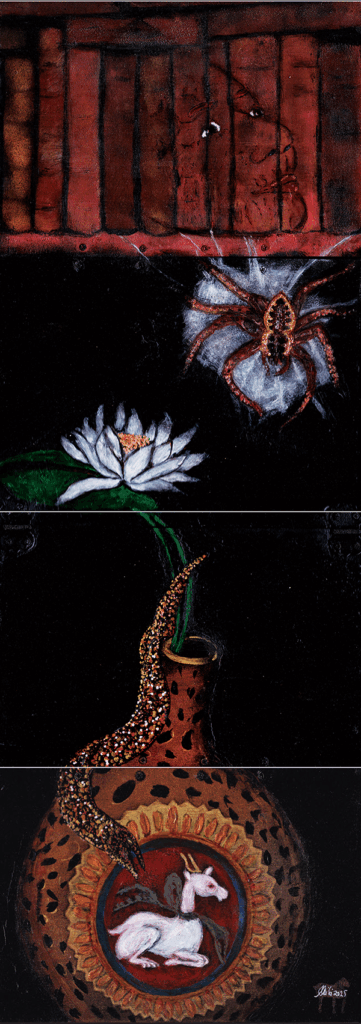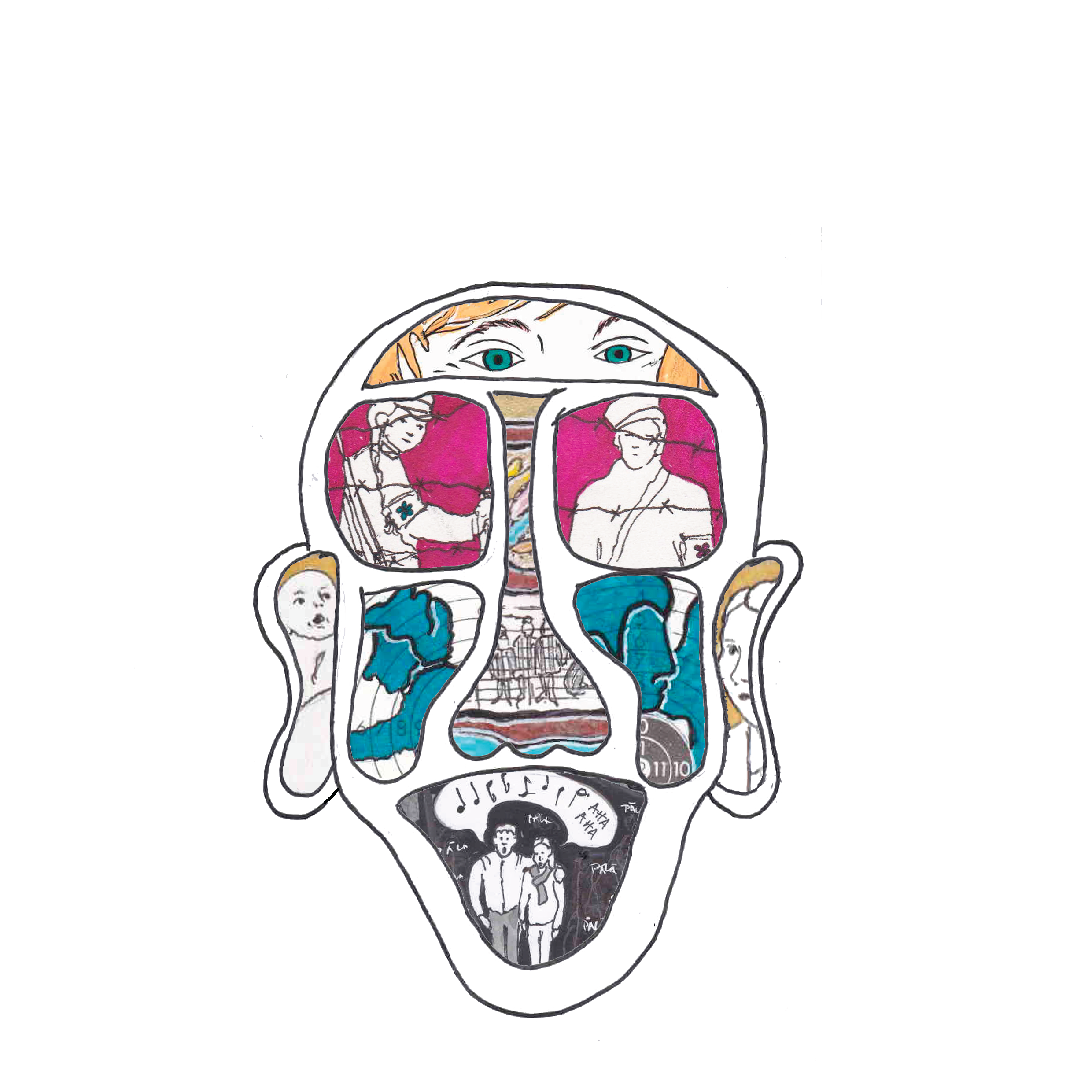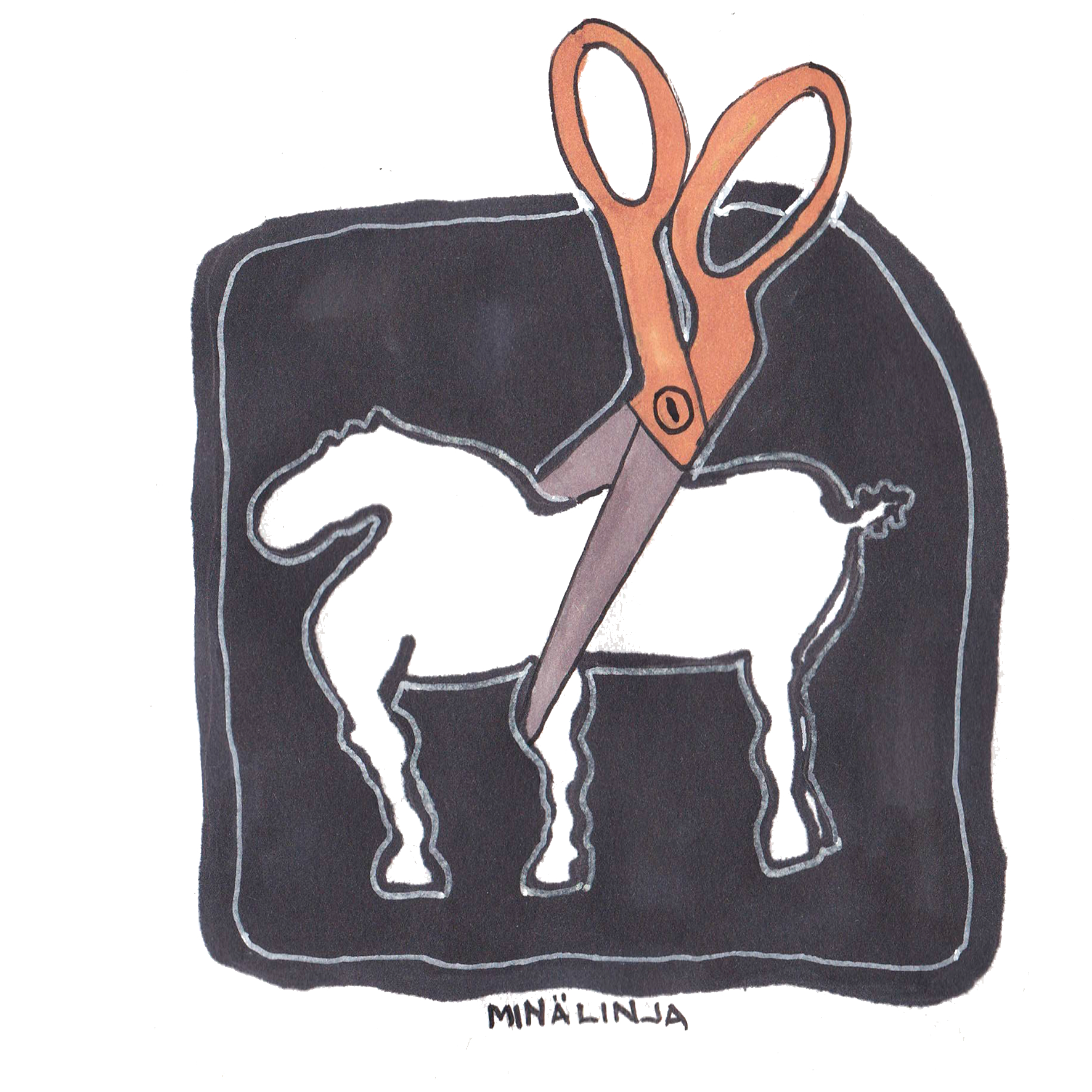Mitä vanhemmaksi tulen, sitä selkeämmäksi minulle käy, että sukupuolella on väliä. Päivä päivältä kuulen enemmän ja enemmän unohdetuista, myyttisistä, arkisista naisista, joiden tarinoista tunnistan paloja itsestäni. Traumoistani, joita olen jo ennen syntymääni kantanut. Iloistani, joiden takana ovat aikojen alun kertomukset. Halusin sanoittaa ne kuviksi, koska minulla – toisin kuin aikojen alun jälkeen useimmilla MaaÄideillä – on lupa puhua.
The older I get, the clearer it becomes to me that gender matters. Day by day, I hear more and more about forgotten, mythical, and ordinary women, in whose stories I recognize parts of myself. Parts of my traumas that I have carried even before my birth. Parts of my joys, behind which are tales from the beginning of time. I wanted to give them form through images, because I—unlike most Earth Mothers after the beginning of time—am allowed to speak.
miksi naiset vaikenivat | why did women fall silent
Sofian tarina (Hagia Sofia) | The Story of Sophia (Hagia Sofia), 2023
“Niinkuin kaikissa pyhien seurakunnissa, olkoot vaimot vaiti teidänkin seurakunnan kokouksissanne, sillä heidän ei ole lupa puhua, vaan olkoot alamaisia, niinkuin lakikin sanoo. Mutta jos he tahtovat tietoa jostakin, niin kysykööt kotonaan omilta miehiltään, sillä häpeällistä on naisen puhua seurakunnassa.”
– 1. Korintilaiskirje, 14. luku, Raamattu, 1933
| Aikojen alussa, ennen Abrahamia,olimme me, Maaäidit ja minä, Sofia, viisaudestani tunnettu. | Ihmiset palvoivat maaäitejä. Olimme yhtä maan, auringon ja luonnon kanssa. | Annoimme voimaa ja toivoa. Olimme ykseys, hedelmällisyys, lohtu hädän hetkellä. | Alkukirkossa olin isän ja pojan rinnalla pyhänä henkenä. Kunnes naisten oli vaiettava ja minut korvasi kyyhky. Mutta sitä ennen me puhuimme. |
| In the beginning of time, before Abraham, there were we, the Earth Mothers and I, Sophia, known for my wisdom. | People worshipped the Earth Mothers. We were one with the earth, the sun, and nature. | We gave strength and hope. We were unity, fertility, comfort in times of distress. | In the early church, I stood beside the Father and the Son as the Holy Spirit. Until women were made to be silent and I was replaced by the dove.But before that, we spoke. |
“Wymmen in chirchis be stille, for it is not sufferable to hem to speke, but to be sugette, as the lawe seith. But if thei wolen learne any thing, at home axe thei her hosebondis; for it is foule thing to a womman to speke in chirche.” – 1 Corinthians 14:34–35, Wycliffe’s Bible, circa 1382
maailmojenluoja | creator of worlds
Naunetin tarina | The Story of Naunet, 2023
“Maailmanloppu on katastrofaalinen tapahtuma, joka johtaa peruuttamattomaan ja laajamittaiseen tuhoon ihmiskunnan sivilisaatiolle ja elämälle maapallolla.” – Tekoäly 2023
| Olen Naunet, alkumeri ja maailman luoja. olin olemassa rajattomana, pimeänä ja vetisenä tyhjyydessä. Ensimmäinen maa-alue, “Benben”,syntyi alkumereni pyörteistä. | Joka aamu synnytän auringon valaisemaan maata ja sen asujaimistoa. Suojelen kaikkea elävää ja elotonta niin maan päällä kuin sen alla ja ympärillä. | Kun ihminen nosti oman kuvansa jumalakseen, unohduin. Kun ihminen nosti itsensä ylitse muiden, alkumereni ja sen synnyttämä maailma alistettiin palvelemaan ihmistä. | Aikoinaan eloisat veteni muuttuvat jälleen pyörteiksi, kaiken peittää pimeys ja Aika muuttuu ikuisuudeksi.Minun tarinani on taas alussa. |
| I am Naunet, the primordial sea and creator of the world. I existed as boundless, dark, and watery emptiness. The first land, ‘Benben’, arose from the whirls of my primordial waters. |
Every morning I give birth to the sun to illuminate the earth and its inhabitants. I protect all that is living and nonliving, both upon the earth and beneath and around it. |
When humankind raised their own image as god, I was forgotten. When humans elevated themselves above all others, my primordial sea and the world it birthed were made to serve humankind. | Once-vital waters will one day turn again to whirls, darkness will cover everything, and Time will become eternity. My story is at its beginning again. |
“The apocalypse is a catastrophic event that leads to irreversible and widespread destruction of human civilization and life on Earth.” – Artificial intelligence, 2023
hallitsematon | uncontrollable
Pelen tarina | The Story of Pele, 2024
“Havaijin Emperor-saariketju on Maailman kuumien pisteiden vulkanismin synnyttämä suuri merenpohja- ja saariketju. Ketjun saarten ja merenpohjan syntyaika on sitä vanhempi, mitä enemmän luoteessa se on. Iän perusteella voidaan laskea Tyynen valtameren laattojen liikettä luoteeseen. Havaijin ketjun nuorin merenpohjan muodostelma, Loihi, purkautuu tällä hetkellä huipultaan 1000 metrin syvyydessä.” – National Ocean Service (America’s Coastal & Ocean Agency), 11.9.2023
| Kauan sitten, Kun Havaijin saaria ei vielä ollut, eli Aliʻi-niminen jumalten suku, joka hallitsi luonnon eri elementtejä. Tähän sukuun, maanjumalatar Haumealle ja taivaan jumala Wakealle, synnyin minä, Pele-honua-mea, kaukana Tyynenmeren horisontin takana Kuaihelanissa. Sain kyvyn hallita tulivuoria ja luoda uutta maata. Tulisieluisuudestani huolimatta Tūtū Pelenä olen pyhä. | Halusin asua Maailmassa. Meloessani kanootilla Tyynellä valtamerellä, Sytytin tulia ja synnytin purkauksia etsiessäni oikeaa saarta asuinpaikakseni. Mutta Niihau, Kauai, Oahu, Molokai, Lanai, Kahoolawe ja Maui eivät tuntuneet omaltani, eikä siskoni Nāmaka, Valtameren jumalatar, sallinut minun niihin asettua. Vasta Hawaiista tuli kotini. | Laskeuduin Kīlauea-vuoren tuliseen syvyyteen ja herätin uinuvan tulivuoren. Puran tunteitani tuomalla saarelle samanaikaisesti elämää ja tuhoa. Suojaa, surua ja hedelmällistä maata. | Rakastan Maailmaa ja sen asukkaita. Mutta olen myös mustasukkainen ja kade. Otan edellen usein yhteen sisareni Nāmakan kanssa. Riitamme johtavat katastrofeihin, kun Nāmaka vastaa tuleeni ja laavaani voimakkailla aalloillaan ja tsunameillaan. Yhdessä olemme muokanneet Tyynen valtameren sellaiseksi kuin se on. Ja työmme on vieläkin kesken. |
| Long ago, when the Hawaiian Islands did not yet exist, there lived a family of gods called the Aliʻi, who ruled over the various elements of nature. Into this family, to Haumea the earth goddess and Wakea the sky god, I was born—I, Pele-honua-mea, far beyond the horizon of the Pacific, in Kuaihelani. I was given the power to control volcanoes and to create new land. Despite my fiery spirit, as Tūtū Pele I am sacred. | I longed to live in the World. While paddling my canoe across the Pacific Ocean, I set fires and caused eruptions as I searched for the right island to make my home. But Niihau, Kauai, Oahu, Molokai, Lanai, Kahoolawe, and Maui did not feel like mine, and my sister Nāmaka, the goddess of the great ocean, did not allow me to settle there. Only Hawaii became my home. | I descended into the fiery depths of Kīlauea and awakened the sleeping volcano. I express my emotions by bringing both life and destruction to the island—protection, sorrow, and fertile land. | I love the World and its inhabitants. But I am also jealous and envious. Even now, I often clash with my sister Nāmaka. Our quarrels lead to catastrophes, as Nāmaka answers my fire and lava with her mighty waves and tsunamis. Together we have shaped the Pacific Ocean into what it is. And our work is still not done. |
“The Hawaiian Emperor seamount chain is a vast underwater and island chain formed by hotspot volcanism. The age of the islands and seafloor in the chain increases the farther northwest it is. Based on their ages, it is possible to calculate the northwestward movement of the Pacific tectonic plates. The youngest seafloor formation in the Hawaiian chain, Lō‘ihi, is currently erupting at a depth of 1,000 meters at its summit.” – National Ocean Service (America’s Coastal & Ocean Agency), September 11, 2023
lähes tasa-arvoinen | nearly equal
Äitinsä varjostaja | Overshadowing Her Mother, 2024
“Kansainvälinen yhteisö on sitoutunut saavuttamaan sukupuolten tasa-arvon vuoteen 2030 mennessä. Vuonna 2024 yksikään maa ei ole saavuttanut sukupuolten tasa-arvoa. Joka kolmas maa ei ole edistynyt vuoden 2015 jälkeen, ja 18 maassa naisten tilanne on jopa huonontunut. Nykyisellä edistymisvauhdilla kestää vielä 131 vuotta saavuttaa sukupuolten välinen tasa-arvo maailmanlaajuisesti.” – https://focus2030.org
| Varjostajana äidinäidinäitini
♀:ille ja ♂:ille yhtäläinen perintöoikeus Äidinäidinäitini on äitilinjani 1. vaaleissa äänioikeutettu |
Varjostajana äidinäitini
1. ♀ ministeriksi ja professoriksi Äidinäitini on äitilinjani 1. ♀liikkeen ja ♀:n oikeuksien aktiivi |
Varjostajana äitini
E-pilleri myytäväksi apteekeissa Äitini on äitilinjani 1. ylioppilas, yliopistossa opiskellut ja opettaja |
Varjostajana minä Avioituvalle oikeus säilyttää sukunimensä Olen perheeni toinen ylioppilas ja maisteri, ensimmäinen kunnallispoliitikko ja ammattiliiton puheenjohtaja. |
| My Mother’s Mother’s Mother as an Overshadower Equal inheritance rights for ♀ and ♂ 1st ♀ to graduate as Master and Doctor Women recognized as fully legal adults at age 21 Equal rights for women to university studies Married women granted the right to earn an income without their husband’s consentMy mother’s mother’s mother was the first in my maternal line to have the right to vote in elections. |
My Mother’s Mother as an Overshadower 1st ♀ to become a minister and a professor Married women freed from the guardianship of their husbands by law Law on maternity and child health clinics established Termination of pregnancy permitted on medical groundsMy mother’s mother was the first in my maternal line to be an activist in the women’s movement and for women’s rights. |
My Mother as an Overshadower
Birth control pill available in pharmacies My mother was the first in my maternal line to complete upper secondary school, to study at university, and to become a teacher. |
I as an Overshadower The right to keep one’s surname upon marriage I am the second university graduate and master’s degree holder in my family, the first local politician and trade union chair |
“The international community is committed to achieving gender equality by 2030. As of 2024, not a single country has achieved gender equality. One third of countries have made no progress since 2015, and in 18 countries the situation for women has even worsened. At the current pace, it will still take 131 years to achieve gender equality worldwide.” – https://focus2030.org
voimistaja | amplifier
Päivä, jolloin tuuli ei lakannut | The Day the Wind Never Ceased, 2025
“Huolimatta näistä ristiriitaisista tiedoista hallitustenvälinen ilmastonmuutospaneeli ennustaa tuulten hidastumista tulevina vuosikymmeninä. Vuoteen 2100 mennessä sen mukaan keskimääräinen vuosittainen tuulennopeus voi laskea jopa 10 prosenttia. ‘Syynä on epätasainen lämpötila — hyvin kylmää navoilla ja lämmintä tropiikissa. Tämä lämpötilaero saa tuulet liikkeelle, ja nyt tuo lämpötilaero on heikkenemässä. Arktinen alue lämpenee nopeammin kuin tropiikit.'” – Global ‘Stilling’: Is Climate Change Slowing Down the Wind?, Yale E360, September 13, 2022
| Aikojen alussa Tuuletar Ilmattaren tytär laittoi lehdet väreilemään, niityn kukat sinkoamaan siemenensä. Lempeästi liplatti Tuuletar aalloilla. Pilvet pisti maata varjelemaan. | Puiden poistuessa, niittyjen hävitessä, Tuuletar tuiversi asfaltilla, merellä myrskynä mylsi, sateet sammutti. | Kuivatti maat, nostatti hiekasta myräkät. Tuuletar raivosi tahtomattaan, muiden teoista tuhosi. | Valoi toivoa, jakoi varjoa, uuden elämän aluksi. |
| At the dawns of time and ages, Tuuletar, daughter born of Ilmatar, set the leaves to softly trembling, sent the meadow’s seeds to soaring. Kindly rippled Tuuletar over wavelet edges, shore’s caresses. Clouds she placed as guards for earth-land, watches keeping, misty borders. |
When the woods withdrew in silence, when the meadows faded, vanished, Tuuletar swept the asphalts bitter, stormed the sea in restless fury, quenched the rain with sternest whisper. | Dried the earth, raised whirling tempests, storms she conjured from the sand-fields. Tuuletar raged not at her choosing, but from others’ deeds destroyed. | Turned back the clock, carried seeds to the soil, little raindrops for the seeds’ pleasure. Poured the hope out, shared the shadow, for the birth of new creation. |
“Despite those conflicting data, the Intergovernmental Panel on Climate Change forecasts slowing winds for the coming decades. By 2100, that body says, average annual wind speeds could drop by up to 10 percent. ‘It’s because of uneven temperatures — very cold at the poles and warm at the tropics. That temperature difference drives the winds, and that temperature difference is weakening. The Arctic is warming faster than the tropics.’” – Global ‘Stilling’: Is Climate Change Slowing Down the Wind?, Yale E360, September 13, 2022
kätketty | veiled
Symbolinen naiseus | Symbolic femininity, 2025
Nainen ei aina näy itse teoksessa, vaikka hänestä taulussa tai kirjassa kerrotaankin. Erityisesti antiikin, keskiajan ja uuden ajan alun Euroopassa kulttuurisia, sosiaalisia tai uskonnollisia syitä, jotka rajoittivat Naisen suoraa esittämistä taiteessa ja kirjallisuudessa. Siksi naiseuteen viittaavia merkkejä ja symboleita, joissa varsinaista naishahmoa ei ole kuvattu, löytyy niin paljon kuvataiteesta kuin kirjallisuudesta. Näissä symboleissa naisen olemusta, rooleja ja ominaisuuksia kuvataan usein esinein, eläinhahmoin, luonnonilmiöin tai muilla kulttuurisilla vertauskuvilla. Vertauskuvien ja symbolien käyttö antaa muille kuin Naiselle / Naisille itselleen valtaa määritellä, miten naiseutta yhteisössä ymmärretään – se on ulkoisen katseen tuote, joka ankkuroi naisen aseman ja roolit yhteiskunnassa.
Symboliit voivat nostaa jonkin naisellisuuden piirteen jalustalle tai syöstä maahan. Jokainen symboli pelkistää ja typistää todellista naiserityisyyttä, monisyisyyttä ja yksilöllisyyttä.
Symbolisessa ilmaisussa Naisen rooli oli usein olla inspiraation tai ihailun kohteena, ei omaääninen kertoja tai toimija. Toisaalta Naisen seksuaalisuudesta ei haluttu puhua – ainakaan Naiselle kuuluvana ominaisuutena. Mutta symboleista tiedämme, onko kyseeessä Madonna vai Huora, Viaton vai Rietas. Pelkkä taiteessa kuvattu tai kirjallisuudessa ilmaistu värikin luonnehtii Naista.
Lyhyt opas näkemään nainen ja naiseus, kun et syystä tai toisesta näe itse naista:
valkoinen = puhdas ja viatonlumme = puhdas, kaunis, viaton, hedelmällisyys, syntymä, feminiini, uudistuminen, “kukka nousee mutaisesta vedestä kirkkaana ja puhtaana”
vihreä = toivo, kasvu
lehti = nuoruus, elämänvoima, kasvu, toivo, uusiutuminen
musta = suru, menetys, itsenäisyys, mysteeri, seksuaalisuus, rakkauden nautinnollisuus, salaperäisyys, mystisyys, epäsovinnaisuus, uhka
hämähäkki = äitiys, kutoja, taitava kädentaito, luova voima, elämänlangan kehrääjä, kohtalon jumalatar
kulta = jalous, menestys, pysyvyys, anteliaisuus, viisaus, viehätysvoima
käärme = hedelmällisyys, viisaus, muodonmuutos, houkutus, kiusaus, pahuus
ruukku = kohtu, elämän alkulähde, hedelmällisyyden astia, kätketty, elämän keskus, elämäntarmo
punainen = intohimo, elämä, seksuaalisuus, riettaus, synti, jumaluus, korkea-arvoisuus
vuohi = kyky synnyttää ja ylläpitää elämää, sitkeys, yhteisön tukipilarisuus
A short guide to seeing woman and femininity when for one reason or another you cannot see the woman herself:
white = pure and innocent
water lily = pure, beautiful, innocent, fertility, birth, feminine, renewal, “a flower rising from muddy water bright and clean”
green = hope, growth
leaf = youth, vitality, growth, hope, renewal
black = sorrow, loss, independence, mystery, sexuality, sensuality of love, secrecy, mystique, unconventionality, threat
spider = motherhood, weaver, skilled craftsmanship, creative force, spinner of the thread of life, goddess of fate
gold = nobility, success, permanence, generosity, wisdom, charm
snake = fertility, wisdom, transformation, temptation, seduction, evil
vessel / jar = womb, source of life, vessel of fertility, hidden, center of life, life force
red = passion, life, sexuality, lust, sin, divinity, high status
goat = ability to give and sustain life, resilience, pillar of the community
A woman is not always visible in the work itself, even if the painting or book is about her. Especially in antiquity, the Middle Ages, and the early modern period in Europe, there were cultural, social, or religious reasons that limited the direct depiction of women in art and literature. That is why there are so many references and symbols of femininity in visual art and literature where no female figure is actually shown. These symbols often depict the essence, roles, and qualities of women through objects, animal figures, natural phenomena, or other cultural metaphors.
The use of metaphors and symbols gives power to define femininity to others instead of to the Woman / Women themselves—it is the product of an external gaze, anchoring the woman’s status and roles in society. Symbols can lift certain feminine traits onto a pedestal or cast them down. Every symbol reduces and simplifies real feminine specificity, complexity, and individuality.
In symbolic expression, a woman’s role was often to be an object of inspiration or admiration, not an independent narrator or actor. On the other hand, people did not want to speak about female sexuality—at least not as a trait belonging to women themselves. Yet from the symbols, we know whether the woman represented is Madonna or Whore, innocent or lascivious. Even the color depicted in art or described in literature characterizes the Woman.









